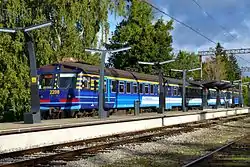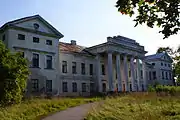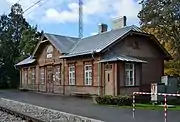Riisipere
Riisipere (German: Riesenberg) is a small borough (alevik) in the Saue Parish, Harju County, Estonia.[1] Prior to the administrative reform of Estonian local governments in March 2017, Riisipere was the administrative center of Nissi Parish. Located on the Ääsmäe-Haapsalu road, its distance from Tallinn is 45 km, from Haapsalu 50 km, Märjamaa 30 km, Rapla 40 km.
Riisipere | |
|---|---|
 A train in Riisipere railway station | |
 Riisipere | |
| Coordinates: 59°07′14″N 24°18′33″E | |
| Country | Estonia |
| County | Harju County |
| Parish | Saue Parish |
| Population (2004) | |
| • Total | 1,051 |
| Time zone | UTC+2 (EET) |
The town
Riisipere railway station, the terminus of the Elron Tallinn-Keila-Riisipere line, has been electrified since 1981. Originally the line continued to Haapsalu. The Riisipere–Haapsalu section was abandoned in 2004,[2] but is due to be rebuilt as far as Turba during 2019, as a first step towards eventually re-opening the line to Haapsalu (and possibly the port at Rohuküla ).[3]
Part of the Riisipere is called Nissi. Near the Nissi, there is located Nissi Church. In Nissi, there is community house, monument for the Estonian War of Independence, cemetery. The first mentioning of Nissi (as a village) was in Danish Census Book.[4]
Apart from the manor, Nissi Church is the main place of interest.[5] The church was built in 1873 and designed by St. Petersburg architect David Grimm.[6]
The composer Raimond Valgre was born in Riispere in 1913.[7]
Riisipere manor
Riisipere manor (German: Neu-Riesenberg) traces its origins as an estate to 1394. It has been owned by various well-known Baltic German families over the centuries. The present building was erected in 1818-1821 during the ownership of Peter von Stackelberg. The grandiose building is one of the finest examples in Estonia of Neoclassical manor house architecture. The front façade is dominated by a six-column portico with a truncated ornamental gable and two three-storeyed side projections. The interior displays an enfilade of representative premises, including a cupola hall, unique in Estonia, and a richly decorated hypostyle "white hall", abundant with details in stucco. The manor is set in a park with an artificial lake.[8][9]
Gallery
 Riisipere manor house
Riisipere manor house.jpg.webp) Nissi church
Nissi church Riisipere train station building
Riisipere train station building.jpg.webp) Water tower in railway station
Water tower in railway station
References
- Riisipere www.efqy.com
- "Eesti Raudteemuuseum" (in Estonian). Archived from the original on 2009-09-07. Retrieved 2008-12-09.
- "Go Track to build Riisipere - Turba railway" (in Ewe). Retrieved 2018-12-30.
- EE, Eesti entsüklopeedia. [Encyclopedia of Estonia] A-Ü. Tallinn: Valgus. 2003. p. 367. ISBN 9985701410.
- "904 Nissi kirik, 1873.a. Mälestised", Kultuurmälestiste (in Estonian), retrieved Dec 2013 Check date values in:
|access-date=(help) - "Church of Blessed Virgin Mary in Nissi on Visit Estonia". Retrieved 19 December 2012.
- "Raimond Valgre Elulugu", www.miksike.ee (in Estonian)
- Sakk, Ivar (2004). Estonian Manors - A Travelogue. Tallinn: Sakk & Sakk OÜ. pp. 36–37. ISBN 9949-10-117-4.
- Viirand, Tiiu (2004). Estonia. Cultural Tourism. Kunst Publishers. p. 54. ISBN 9949-407-18-4.
External links
| Wikimedia Commons has media related to Riisipere. |
- Riisipere matkad.elektriaudtee.ee
- Riisipere manor on Estonian Manors Portal
| Previous station | Next station | |
| Turba |